Yaqing Wang
SC2Arena and StarEvolve: Benchmark and Self-Improvement Framework for LLMs in Complex Decision-Making Tasks
Aug 14, 2025Abstract:Evaluating large language models (LLMs) in complex decision-making is essential for advancing AI's ability for strategic planning and real-time adaptation. However, existing benchmarks for tasks like StarCraft II fail to capture the game's full complexity, such as its complete game context, diverse action spaces, and all playable races. To address this gap, we present SC2Arena, a benchmark that fully supports all playable races, low-level action spaces, and optimizes text-based observations to tackle spatial reasoning challenges. Complementing this, we introduce StarEvolve, a hierarchical framework that integrates strategic planning with tactical execution, featuring iterative self-correction and continuous improvement via fine-tuning on high-quality gameplay data. Its key components include a Planner-Executor-Verifier structure to break down gameplay, and a scoring system for selecting high-quality training samples. Comprehensive analysis using SC2Arena provides valuable insights into developing generalist agents that were not possible with previous benchmarks. Experimental results also demonstrate that our proposed StarEvolve achieves superior performance in strategic planning. Our code, environment, and algorithms are publicly available.
Beyond Markovian: Reflective Exploration via Bayes-Adaptive RL for LLM Reasoning
May 26, 2025Abstract:Large Language Models (LLMs) trained via Reinforcement Learning (RL) have exhibited strong reasoning capabilities and emergent reflective behaviors, such as backtracking and error correction. However, conventional Markovian RL confines exploration to the training phase to learn an optimal deterministic policy and depends on the history contexts only through the current state. Therefore, it remains unclear whether reflective reasoning will emerge during Markovian RL training, or why they are beneficial at test time. To remedy this, we recast reflective exploration within the Bayes-Adaptive RL framework, which explicitly optimizes the expected return under a posterior distribution over Markov decision processes. This Bayesian formulation inherently incentivizes both reward-maximizing exploitation and information-gathering exploration via belief updates. Our resulting algorithm, BARL, instructs the LLM to stitch and switch strategies based on the observed outcomes, offering principled guidance on when and how the model should reflectively explore. Empirical results on both synthetic and mathematical reasoning tasks demonstrate that BARL outperforms standard Markovian RL approaches at test time, achieving superior token efficiency with improved exploration effectiveness. Our code is available at https://github.com/shenao-zhang/BARL.
Dense Communication between Language Models
May 19, 2025Abstract:As higher-level intelligence emerges from the combination of modular components with lower-level intelligence, many works combines Large Language Models (LLMs) for collective intelligence. Such combination is achieved by building communications among LLMs. While current systems primarily facilitate such communication through natural language, this paper proposes a novel paradigm of direct dense vector communication between LLMs. Our approach eliminates the unnecessary embedding and de-embedding steps when LLM interact with another, enabling more efficient information transfer, fully differentiable optimization pathways, and exploration of capabilities beyond human heuristics. We use such stripped LLMs as vertexes and optimizable seq2seq modules as edges to construct LMNet, with similar structure as MLPs. By utilizing smaller pre-trained LLMs as vertexes, we train a LMNet that achieves comparable performance with LLMs in similar size with only less than 0.1% training cost. This offers a new perspective on scaling for general intelligence rather than training a monolithic LLM from scratch. Besides, the proposed method can be used for other applications, like customizing LLM with limited data, showing its versatility.
Understanding the Uncertainty of LLM Explanations: A Perspective Based on Reasoning Topology
Feb 24, 2025Abstract:Understanding the uncertainty in large language model (LLM) explanations is important for evaluating their faithfulness and reasoning consistency, and thus provides insights into the reliability of LLM's output regarding a question. In this work, we propose a novel framework that quantifies uncertainty in LLM explanations through a reasoning topology perspective. By designing a structural elicitation strategy, we guide the LLMs to frame the explanations of an answer into a graph topology. This process decomposes the explanations into the knowledge related sub-questions and topology-based reasoning structures, which allows us to quantify uncertainty not only at the semantic level but also from the reasoning path. It further brings convenience to assess knowledge redundancy and provide interpretable insights into the reasoning process. Our method offers a systematic way to interpret the LLM reasoning, analyze limitations, and provide guidance for enhancing robustness and faithfulness. This work pioneers the use of graph-structured uncertainty measurement in LLM explanations and demonstrates the potential of topology-based quantification.
ConML: A Universal Meta-Learning Framework with Task-Level Contrastive Learning
Oct 08, 2024



Abstract:Meta-learning enables learning systems to adapt quickly to new tasks, similar to humans. To emulate this human-like rapid learning and enhance alignment and discrimination abilities, we propose ConML, a universal meta-learning framework that can be applied to various meta-learning algorithms without relying on specific model architectures nor target models. The core of ConML is task-level contrastive learning, which extends contrastive learning from the representation space in unsupervised learning to the model space in meta-learning. By leveraging task identity as an additional supervision signal during meta-training, we contrast the outputs of the meta-learner in the model space, minimizing inner-task distance (between models trained on different subsets of the same task) and maximizing inter-task distance (between models from different tasks). We demonstrate that ConML integrates seamlessly with optimization-based, metric-based, and amortization-based meta-learning algorithms, as well as in-context learning, resulting in performance improvements across diverse few-shot learning tasks.
GraphIC: A Graph-Based In-Context Example Retrieval Model for Multi-Step Reasoning
Oct 03, 2024



Abstract:In-context learning (ICL) enables large language models (LLMs) to generalize to new tasks by incorporating a few in-context examples (ICEs) directly in the input, without updating parameters. However, the effectiveness of ICL heavily relies on the selection of ICEs, and conventional text-based embedding methods are often inadequate for tasks that require multi-step reasoning, such as mathematical and logical problem solving. This is due to the bias introduced by shallow semantic similarities that fail to capture the deeper reasoning structures required for these tasks. We present GraphIC, a novel approach that leverages graph-based representations of reasoning processes, coupled with Bayesian Networks (BNs) to select ICEs. Graph structures inherently filter out shallow semantics while preserving the core reasoning structure. Importantly, BNs capture the dependency of a node's attributes on its parent nodes, closely mirroring the hierarchical nature of human cognition-where each thought is shaped by preceding ones. This makes BNs particularly well-suited for multi-step reasoning tasks, aligning the process more closely with human-like reasoning. Extensive experiments across three types of reasoning tasks (mathematical reasoning, code generation, and logical reasoning) demonstrate that GraphIC outperforms both training-free and training-based models in selecting ICEs, excelling in terms of both effectiveness and efficiency. We show that GraphIC enhances ICL's performance and interoperability, significantly advancing ICE selection for multi-step reasoning tasks.
Development and Testing of a Vine Robot for Urban Search and Rescue in Confined Rubble Environments
Sep 16, 2024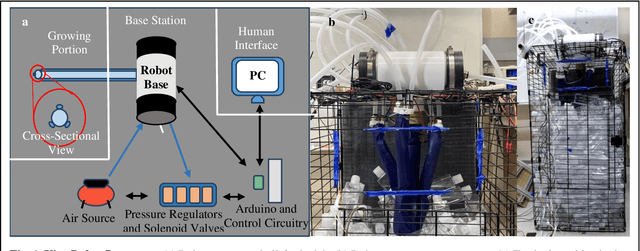
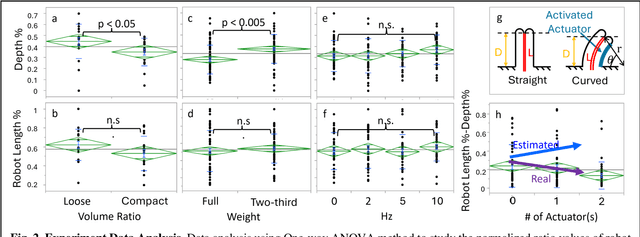
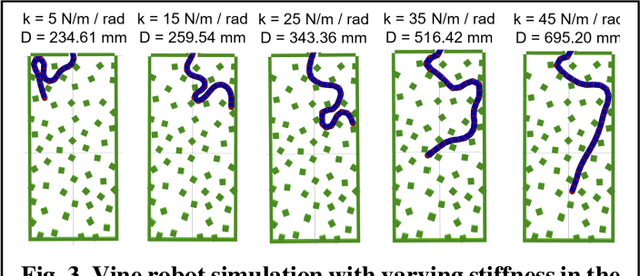
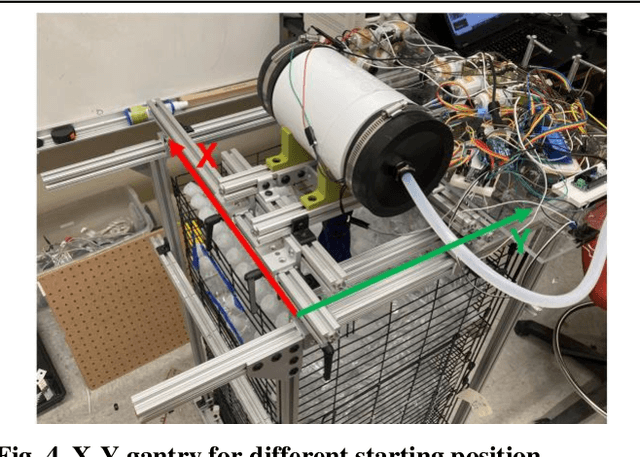
Abstract:The request for fast response and safe operation after natural and man-made disasters in urban environments has spurred the development of robotic systems designed to assist in search and rescue operations within complex rubble sites. Traditional Unmanned Aerial Vehicles (UAVs) and Unmanned Ground Vehicles (UGVs) face significant limitations in such confined and obstructed environments. This paper introduces a novel vine robot designed to navigate dense rubble, drawing inspiration from natural growth mechanisms found in plants. Unlike conventional robots, vine robots are soft robots that can grow by everting their material, allowing them to navigate through narrow spaces and obstacles. The prototype presented in this study incorporates pneumatic muscles for steering and oscillation, an equation-based robot length control plus feedback pressure regulating system for extending and retracting the robot body. We conducted a series of controlled experiments in an artificial rubble testbed to assess the robot performance under varying environmental conditions and robot parameters, including volume ratio, environmental weight, oscillation, and steering. The results show that the vine robot can achieve significant penetration depths in cluttered environments with mixed obstacle sizes and weights, and can maintain repeated trajectories, demonstrating potential for mapping and navigating complex underground paths. Our findings highlight the suitability of the vine robot for urban search and rescue missions, with further research planned to enhance its robustness and deployability in real-world scenarios.
FIARSE: Model-Heterogeneous Federated Learning via Importance-Aware Submodel Extraction
Jul 28, 2024
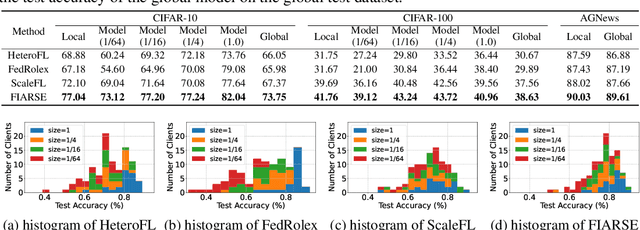


Abstract:In federated learning (FL), accommodating clients' varied computational capacities poses a challenge, often limiting the participation of those with constrained resources in global model training. To address this issue, the concept of model heterogeneity through submodel extraction has emerged, offering a tailored solution that aligns the model's complexity with each client's computational capacity. In this work, we propose Federated Importance-Aware Submodel Extraction (FIARSE), a novel approach that dynamically adjusts submodels based on the importance of model parameters, thereby overcoming the limitations of previous static and dynamic submodel extraction methods. Compared to existing works, the proposed method offers a theoretical foundation for the submodel extraction and eliminates the need for additional information beyond the model parameters themselves to determine parameter importance, significantly reducing the overhead on clients. Extensive experiments are conducted on various datasets to showcase superior performance of the proposed FIARSE.
Warming Up Cold-Start CTR Prediction by Learning Item-Specific Feature Interactions
Jul 14, 2024Abstract:In recommendation systems, new items are continuously introduced, initially lacking interaction records but gradually accumulating them over time. Accurately predicting the click-through rate (CTR) for these items is crucial for enhancing both revenue and user experience. While existing methods focus on enhancing item ID embeddings for new items within general CTR models, they tend to adopt a global feature interaction approach, often overshadowing new items with sparse data by those with abundant interactions. Addressing this, our work introduces EmerG, a novel approach that warms up cold-start CTR prediction by learning item-specific feature interaction patterns. EmerG utilizes hypernetworks to generate an item-specific feature graph based on item characteristics, which is then processed by a Graph Neural Network (GNN). This GNN is specially tailored to provably capture feature interactions at any order through a customized message passing mechanism. We further design a meta learning strategy that optimizes parameters of hypernetworks and GNN across various item CTR prediction tasks, while only adjusting a minimal set of item-specific parameters within each task. This strategy effectively reduces the risk of overfitting when dealing with limited data. Extensive experiments on benchmark datasets validate that EmerG consistently performs the best given no, a few and sufficient instances of new items.
Knowledge-Aware Parsimony Learning: A Perspective from Relational Graphs
Jun 29, 2024Abstract:The scaling law, a strategy that involves the brute-force scaling of the training dataset and learnable parameters, has become a prevalent approach for developing stronger learning models. In this paper, we examine its rationale in terms of learning from relational graphs. We demonstrate that directly adhering to such a scaling law does not necessarily yield stronger models due to architectural incompatibility and representation bottlenecks. To tackle this challenge, we propose a novel framework for learning from relational graphs via knowledge-aware parsimony learning. Our method draws inspiration from the duality between data and knowledge inherent in these graphs. Specifically, we first extract knowledge (like symbolic logic and physical laws) during the learning process, and then apply combinatorial generalization to the task at hand. This extracted knowledge serves as the ``building blocks'' for achieving parsimony learning. By applying this philosophy to architecture, parameters, and inference, we can effectively achieve versatile, sample-efficient, and interpretable learning. Experimental results show that our proposed framework surpasses methods that strictly follow the traditional scaling-up roadmap. This highlights the importance of incorporating knowledge in the development of next-generation learning technologies.
 Add to Chrome
Add to Chrome Add to Firefox
Add to Firefox Add to Edge
Add to Edge